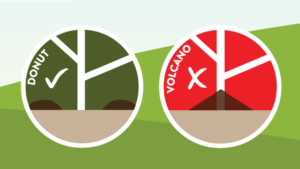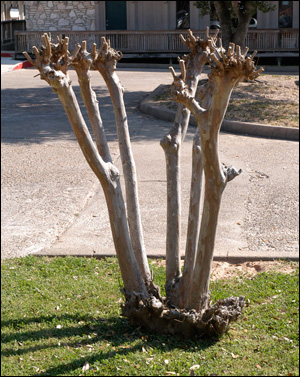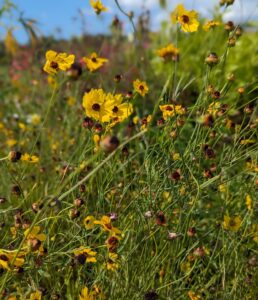By: Anna Stubbendick, FCHP
Landscaping in the central Florida area is both an art and a science, and mastering it requires a good dose of knowledge. At Canterbury Farms Nursery & Garden Center, we understand the unique challenges and opportunities this region presents for gardeners. Let’s delve into some common landscaping missteps and explore the science-backed solutions, drawing from the expertise of UF/IFAS (University of Florida’s Institute of Food and Agricultural Sciences).

A drawing or plan can help you lay out your design and make sure your plants are properly spaced to accommodate their mature sizes.
1. Growing Pains: The Art of Plant Planning
Planting without considering future growth is a classic blunder. Central Florida’s climate is a breeding ground for lush vegetation, so plant selection and spacing are vital. UF/IFAS emphasizes the importance of choosing plants that fit the available space. Overcrowding not only affects aesthetics but also the health of your plants as they compete for resources. Remember, measure twice, plant once! Here are some general spacing guidelines for different plant sizes to get you started:
- – 1 gal perennials & groundcovers: 12″-18″ on center
- – 3 gal shrubs: 30″-36″ on center
- – 7 gal shrubs: 36″-60″ on center
Take the time to research the plants that you are hoping to use so that you are familiar with their growth habits, light needs, cold-hardiness, and common pest issues. The first rule of Florida-Friendly Landscaping is “Right plant, right place.” You want to make sure your plants will thrive in the conditions that they will be planted into. The staff at Canterbury Farms are an excellent resource, as are the folks at your local county Extension office, and can advise you as to proper plant selection for your spaces.
2. Wet ‘n’ Wild: Mastering Irrigation
Inconsistent watering can spell trouble for your garden, given Florida’s variable rainfall patterns. UF/IFAS suggests utilizing a rain gauge to monitor precipitation levels and to use a rain sensor on your automatic irrigation system. Adjust your irrigation regimen accordingly to prevent overwatering, which can lead to root rot and other issues. Keeping your plants’ feet dry is essential for their well-being.

One of the most common examples of incorrect mulching is “volcano mulching,” in which excessive amounts of mulch materials are applied at the base of plants and piles against the trunks or stems, creating a volcano shape. Mulch should not touch the stem or trunk of your plant and doing so can lead to improper root growth, decay, and infestation.
Believe it or not, water conservation is becoming an increasingly important issue. You should perform an inspection of your automatic irrigation system at least annually. Observe the spray patterns and adjust the heads and rotors accordingly so that they are not spraying onto impervious surfaces like sidewalks and driveways. It’s also a good idea to position any rain gutter downspouts to flow either into a plant bed or into the lawn, which allows the water to be taken up by the plants rather than run off into the stormwater collection system.
3. Mulch It, Don’t Smother It
Mulch is a valuable tool for moisture retention, temperature regulation, and weed control. It should be applied to a depth of 2-3 inches for maximum benefits. However, be cautious not to mulch too close to the base of your plants. UF/IFAS advises maintaining a gap to prevent root rot and diseases. Avoid “volcano” mulching or piling on excessive mulch, which can suffocate your plants’ root systems.

Don’t try this at home: an example of “Crape Murder.” Photo by UF/IFAS
4. Say No to “Crape Murder”
Improper pruning can seriously harm your Crape Myrtle trees. UF/IFAS strongly discourages “Crape Murder,” a term used for excessive topping. Instead, follow correct pruning techniques by removing dead or crossing branches, and only remove branches that are less than 1″ in diameter. This promotes healthier growth and maintains the tree’s structural integrity. Pruning is best done in early spring after the last danger of frost has passed. However, if you like, throughout the summer, you may clip off the spent blooms just below the flower panicle in order to promote a second round of blooms.
5. Lawn Drama: Florida Edition
Central Florida’s warm and humid climate can present challenges in lawn care. UF/IFAS recommends selecting the appropriate grass species for your area and adhering to a consistent mowing and fertilization schedule. Overfertilization can lead to nutrient runoff, adversely affecting local water bodies. Finding the right balance is crucial for a thriving lawn.
It is also important to make sure that your mower is set to the appropriate height for your species of turfgrass. A good rule of thumb is to never cut more than one third of the length of the grass blade any time you mow. If your grass is overgrown, it’s recommended to mow your grass down to the correct height over several cutting cycles, not all at once. Keeping your grass at the higher end of the recommended height range also allows the roots to develop deeper, which will make your lawn more drought-tolerant.
Another common mistake occurs when grass is planted in very shady locations. Most varieties of turfgrasses require at least six hours of full sun in order to be resilient enough to outgrow competing weeds. If you have a shady location, you may want to consider switching to a more shade-tolerant turfgrass alternative or creating a shade-tolerant landscape plant bed.

Native flora, like this Tickseed (Coreopsis leavenworthii) are havens for wildlife, especially pollinators. Photo by Anna Stubbendick, Canterbury Farms
6. Go Native and Thrive
Central Florida boasts a rich diversity of native plants, perfectly suited to the local climate. These plants typically require less maintenance and also support local wildlife. UF/IFAS encourages homeowners to consider incorporating native species into their landscapes. Doing so not only conserves resources but also fosters a thriving ecosystem in your garden.
Cultivating Success
Landscaping is an endeavor that combines creativity with scientific understanding. By taking heed of these common landscaping mistakes and heeding expert advice, you can cultivate a vibrant and sustainable outdoor space. At Canterbury Farms Nursery & Garden Center, we are committed to helping you create a beautiful and thriving landscape that embraces the unique characteristics of our area. Gardening in this region is both an art and a science, and with the right knowledge, your garden will flourish.
For more information, check out these helpful links:
Florida-Friendly Landscaping Handbook for Home Landscapes
Landscape Design: Drawing a Planting Plan
Gardening Solutions: Pruning Crape Myrtle
Florida-Friendly Landscaping Program: Water Efficiently Guidance

